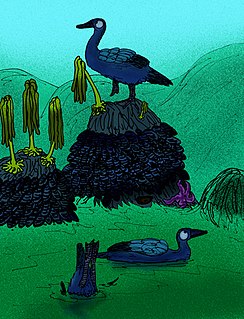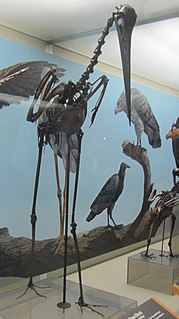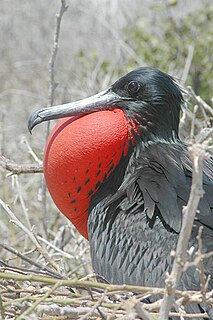 W
WAsphaltoglaux cecileae is an extinct species of true owl which existed in what is now California, U.S.A. during the Late Pleistocene age. The species is known from the La Brea Tar Pits. Its osteology suggests a close relation to the owls of the genus Aegolius.
 W
WThe great auk is a species of flightless alcid that became extinct in the mid-19th century. It was the only modern species in the genus Pinguinus. It is not closely related to the birds now known as penguins, which were discovered later and so named by sailors because of their physical resemblance to the great auk.
 W
WThe Californian turkey is an extinct species of turkey indigenous to the Pleistocene and early Holocene of California. It has been estimated that the Californian turkey went extinct about 10,000 years ago.
 W
WChendytes lawi is an extinct, goose-sized flightless seaduck, once common on the California coast, the California Channel Islands, and possibly southern Oregon. It lived in the Pleistocene and survived into the Holocene. It appears to have gone extinct at about 450–250 BCE. IThe youngest direct radiocarbon date from a Chendytes bone fragment dates to 770–400 BCE and was found in an archeological site in Ventura County. Its remains have been found in fossil deposits and in early coastal archeological sites. Archeological data from coastal California show a record of human exploitation of Chendytes lawi for at least 8,000 years. It was probably driven to extinction by hunting, animal predation, and loss of habitat. Chendytes bones have been identified in archaeological assemblages from 14 coastal sites, including two on San Miguel Island and 12 in mainland localities. Hundreds of Chendytes bones and egg shells found in Pleistocene deposits on San Miguel Island have been interpreted as evidence that some of these island fossil localities were nesting colonies, one of which Guthrie dated to �12,000 14C years. There is nothing in the North American archaeological record indicating a span of exploitation for any megafaunal genus remotely as long as that of Chendytes.
 W
WCiconia maltha, also known as the asphalt stork or La Brea stork, is an extinct stork from the Late Pliocene – Late Pleistocene of United States, Cuba and Bolivia. It has been found in the La Brea Tar Pits.
 W
WDow's puffin is an extinct seabird in the auk family described in 2000 from subfossil remains found in the Channel Islands of California.
 W
WFrigatebirds are a family of seabirds called Fregatidae which are found across all tropical and subtropical oceans. The five extant species are classified in a single genus, Fregata. All have predominantly black plumage, long, deeply forked tails and long hooked bills. Females have white underbellies and males have a distinctive red gular pouch, which they inflate during the breeding season to attract females. Their wings are long and pointed and can span up to 2.3 metres (7.5 ft), the largest wing area to body weight ratio of any bird.
 W
WGlaucidium kurochkini is an extinct species of pygmy owls that existed in what is now California, U.S.A. during the late Pleistocene epoch.
 W
WThe Californian turkey is an extinct species of turkey indigenous to the Pleistocene and early Holocene of California. It has been estimated that the Californian turkey went extinct about 10,000 years ago.
 W
WNeogyps is an extinct monotypic genus of Aegypiinae from the Pleistocene.
 W
WNeophrontops is an extinct genus of Accipitridae from the Pleistocene.
 W
WOraristix brea, the Brea owl, is an extinct owl reported from the upper Pleistocene asphalt deposits of the La Brea Tar Pits in Los Angeles, California. It was first described in 1933 by Hildegarde Howard as Strix brea, but this extinct owl was recently placed into its own genus by Campbell and Bocheński (2010). The Brea owl has also been found in the upper Pleistocene asphalt deposits of Carpinteria, California. Oraristrix brea is interpreted as more terrestrial in habits than forest owls because, compared to North American species of Bubo and Strix, it had longer legs relative to its wingspan.
 W
WThe Cuban giant owl or giant cursorial owl (Ornimegalonyx) is an extinct genus of giant owl that measured 1.1 metres in height. It is closely related to the many species of living owls of the genus Strix. It was a flightless or nearly flightless bird and it is believed to be the largest owl that ever existed. It lived on the island of Cuba.
 W
WPodilymbus is a genus of birds in the Grebe family, containing the extinct Atitlán grebe and the pied-billed grebe. The genus name is derived from Latin Podilymbus, a contraction of podicipes —the origin of the name of the grebe order—and Ancient Greek kolymbos, "diver".
 W
WRhynchopsitta phillipsi is an extinct species of thick-billed parrot. It was described in 1997 from Late Pleistocene cave deposits from Nuevo León in northeastern Mexico. The specific epithet honours American ornithologist Allan Robert Phillips. This thick-billed parrot is rare species that once had vast numbers in the United States. They're endangered due to habitat loss and the illegal pet trade. Therefore the Mexican Government is renting the forests where they live to keep people from selling off the logs so their numbers will go up in the wild.
 W
WTeratornis was a genus of huge North American birds of prey – the best-known of the teratorns - of which, two species are known to have existed: Teratornis merriami and Teratornis woodburnensis. A large number of fossil and subfossil bones, representing more than 100 individuals, have been found in locations in California, Oregon, southern Nevada, Arizona, and Florida, though most are from the Californian La Brea Tar Pits. All remains except one Early Pleistocene partial skeleton from the Leisey Shell Pit near Charlotte Harbor, Florida date from the Late Pleistocene, with the youngest remains dating from the Pleistocene-Holocene boundary.
 W
WTeratornithidae is an extinct family of very large birds of prey that lived in North and South America from the Late Oligocene to Late Pleistocene. They include some of the largest known flying birds.
 W
WTitanis is an extinct genus of giant flightless terror birds that inhabited North America during the early Pliocene to early Pleistocene epochs. The generic name, Titanis, refers to the titans, Ancient Greek gods that preceded the Twelve Olympians, in allusion to the bird's size. The specific name, T. walleri, honors the holotype's collector, Benjamin I. Waller, an avocational underwater archaeologist. Titanis was thought to be carnivorous and most likely preyed on the many small mammals of the time period. This giant flightless bird was one of the most efficient predators of its time in North America.
 W
WWoodward's eagle is an extinct species of eagle that lived in North America and the Caribbean during the Late Pleistocene. It is one of the largest birds of prey ever found, with an estimated total length 95.6 to 110.2 cm, as quite as large as the Harpy eagle. Haast's eagle reached bigger lengths but appears to have been both somewhat more robust than Woodward's, as Haast's was a forest-dwelling species. Woodward's eagle appears to have hunted in open habitats, taking primarily small mammals and reptiles.